Washington Metro
| Metrorail | |
 |
|
| Info | |
|---|---|
| Locale | Washington Metropolitan Area |
| Transit type | Rapid transit |
| Number of lines | 5 |
| Number of stations | 86 |
| Daily ridership | 798,456 (avg. weekday, June 2008) |
| Operation | |
| Began operation | March 27, 1976 |
| Operator(s) | Washington Metropolitan Area Transit Authority (WMATA) |
| Technical | |
| System length | 106.3 mi (171 km) |
| Track gauge | 1,435 mm (4 ft 8½ in) (standard gauge) |
The Washington Metro (officially Metrorail, but commonly referred to as Metro) is the rapid transit system of Washington, D.C., and neighboring communities in Maryland and Virginia, both inside and outside the Capital Beltway, and is the second busiest in the United States behind the New York City Subway. In Maryland, service is provided in Prince George's County and Montgomery County; in Virginia, service extends to Fairfax County, Arlington County, and the city of Alexandria.
Overview
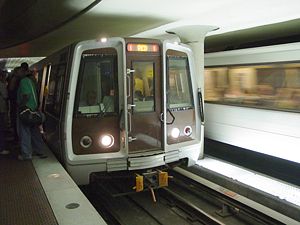

The Metrorail (subway) system and the Metrobus (bus) network are owned and operated by the Washington Metropolitan Area Transit Authority (WMATA) — a multijurisdictional, quasi-governmental agency. WMATA also operates a paratransit service for persons with disabilities called Metro Access. However, the expression "Metro" usually refers to Metrorail exclusively.
Metrorail fare is zoned, and as a result it varies based on the distance traveled and the time of day. Riders enter and exit the system using a stored-value card in the form of a paper magnetic stripe farecard or a proximity card known as SmarTrip. Both methods track the balance paid to Metro, as well as the rider's entry and exit points.
Since opening in 1976, the subway network has grown to five lines, consisting of 86 stations and 106.3 miles (171 kilometers) of track. The original plan of 83 stations on 103 miles (166 kilometers) was completed on January 13, 2001. There were 215.3 million trips, or 727,684 trips per weekday, on Metrorail in fiscal year 2008.[1] In June 2008, Metrorail set a new monthly ridership record with 19,729,641 trips, or 798,456 per weekday.[1]
Metrorail was designed by Chicago architect Harry Weese, and is an example of late-20th century modern architecture. With its heavy use of concrete and the repetitive nature of its design motifs, it displays aspects of Brutalism, which in Washington is also illustrated by the FBI's J. Edgar Hoover Building. Simultaneously, with its coffered groin and barrel vaults, it evokes Neoclassicism, arguably the closest thing to an "official" architectural style in Washington. Historic examples of Neoclassicism in Washington consist of the U.S. Department of the Treasury, by Robert Mills and others; the former U.S. Patent Office building (now the Smithsonian American Art Museum), also by Robert Mills and others; the White House, by James Hoban; and the Beaux-Arts Lincoln Memorial, by Henry Bacon. In 2007, the design of the vaulted Metrorail stations was voted #106 on the list of America's Favorite Architecture, conducted by the American Institute of Architects in conjunction with Harris Interactive.
In underground stations, light is provided via banks of fluorescent lights next to the station walls. Additional light is provided in center platform stations by lights in the crowns of the platform pylons. In side-platform stations, additional lighting is provided by banks of fluorescent lights between the tracks. In all stations, as a signal to passengers, a row of lights embedded in the platform's granite edge flash when a train is about to arrive. This is not controlled by the central computer, but is activated by a simple track circuit indication; the lights also flash when a diesel-powered work train approaches or stops in a station.
Metrorail network
The network was designed with a spoke-hub distribution paradigm, which makes the subway ideal for getting from a suburb to any part of the city, or vice versa, but unattractive for suburb-to-suburb travel; groups have proposed a Purple Line connecting the two ends of the Red Line to remedy this. The system is also noteworthy as a system with a limited number of lines that makes extensive use of interlining (running more than one service on the same track).
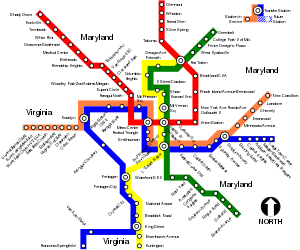
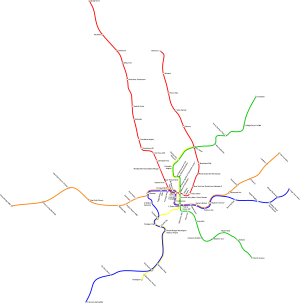
There are five operating lines and two planned lines:
| Line Name | Opened | Stations | Termini | |
|---|---|---|---|---|
| Red Line | 1976 | 27 | Shady Grove - Glenmont | |
| Orange Line | 1978 | 26 | Vienna/Fairfax-GMU - New Carrollton | |
| Blue Line | 1977 | 27 | Franconia-Springfield - Largo Town Center | |
| Yellow Line | 1983 | 17 | Huntington - Fort Totten / Mt Vernon Sq/7th St-Convention Center | |
| Green Line | 1991 | 21 | Branch Ave - Greenbelt | |
| Silver Line (Planned) | Route 772 - Stadium-Armory |
There are currently stations in the District of Columbia, Prince George's County and Montgomery County in Maryland, and Fairfax County, Arlington County, and the city of Alexandria in Virginia. The Silver Line will add stations in Loudoun County, Virginia, once completed.
Half of the system, including most of the stations in the District of Columbia, is underground, but most suburban stations are on elevated rails or at grade. In the case of the western Orange Line, the tracks run in the median of Interstate 66. The deepest stations in the system are at the northeastern end of the Red Line, with Wheaton having the longest escalator in the western hemisphere at 230 feet (70 m) long, and Forest Glen being even deeper than that.[2] From that station, the only way to the surface is by elevator.[3]
The system is not centered on any single station, but Metro Center is considered the hub; one of the busiest stations, it is located at the intersection of the three busiest lines, and the Metro Information Center and Gift Shop are located there. Other notable transfer stations include Gallery Place/Chinatown (located beneath the Verizon Center), Stadium-Armory (located near RFK Stadium), and L'Enfant Plaza, the only station in the system with service to four lines.
Various colleges and universities are accessible through the Metro, including:
- American University from Tenleytown-AU
- American University Washington College of Law, also from Tenleytown-AU.
- The Catholic University of America from Brookland-CUA
- The University of the District of Columbia from Van Ness-UDC
- Gallaudet University from New York Ave-Florida Ave-Gallaudet U
- Georgetown University from Rosslyn (via shuttle bus or a long walk across the Key Bridge) or Dupont Circle
- Georgetown University Law Center from Judiciary Square and Union Station
- The George Washington University from Foggy Bottom-GWU
- George Mason University from Vienna/Fairfax-GMU (Main Campus) and Virginia Square-GMU (Arlington Campus, including George Mason University School of Law)
- Howard University from Shaw-Howard Univ
- Howard University Law School from Van Ness-UDC
- The University of Maryland, College Park from College Park-U of Md
- Marymount University from Ballston–MU
- Southeastern University from Waterfront–SEU
- Trinity University from Brookland-CUA
- Johns Hopkins University, Carey School of Professional Studies in Business and Education (at Washington DC Center Campus) and Paul H. Nitze School of Advanced International Studies (SAIS) from Dupont Circle
Since 1999, Metro has run a special service pattern on July 4 to accommodate movements into and out of the city for Independence Day activities on the National Mall. This generally involves switching the southern terminals for the Blue and Yellow Lines (Yellow Line trains terminate at Huntington, while Blue Line trains terminate at Franconia-Springfield), terminating the Blue Line at the Rosslyn upper level, and sending Orange Line trains to both Largo Town Center and New Carrollton. Since 2002, Smithsonian station has been closed all day on July 4 because its entrances are located within the secured perimeter established around the Mall.[4]
WMATA has a stated goal of integration of its rail and bus networks. In 2004, SmarTrip readers were installed on all buses, enabling paperless transfers between lines and with the rail system.[5] Metro also offers numerous connections to other transit systems and modes of transportation in Washington, D.C.
- See also: List of Washington Metro stations
Yellow Line extension
Beginning December 31, 2006, Metro extended its Yellow Line service past Mt Vernon Sq/7th St-Convention Center to Fort Totten during off-peak hours as part of an 18-month pilot program. This adds five stations to the existing Yellow Line route and increases off-peak service (non-rush hour) from one train every 12 minutes, to one train every six minutes. Metro installed over 5,000 signs throughout the system to reflect the extension. The $5.75 million cost of the expansion will be covered by the District of Columbia.[6]
History
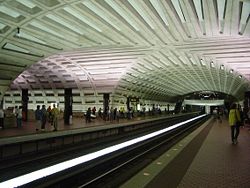

During the 1960s, there were plans for a massive freeway system in Washington. However, opposition to this freeway system grew. Harland Bartholomew who chaired the National Capital Planning Commission thought that a rail transit system would never be self-sufficient because of low density land uses and general transit ridership decline.[7] Finally, a mixed concept of a Capital Beltway system along with rail line radials was agreed upon. The Beltway received full funding; monies for the ambitious Inner Loop Freeway system were partially reallocated toward construction of the Metro system.[8]
In 1960, the federal government created the National Capital Transportation Agency to develop a rapid rail system. Then in 1966, a bill creating WMATA was passed by the federal government, the District of Columbia, Virginia, and Maryland,[9] with planning power for the system being transferred to it from the NCTA.[10] WMATA approved plans for a 98-mile (158 km) regional system in 1968,[10] and construction on the metro began in 1969, with groundbreaking on December 9. The system opened March 27, 1976, with 4.6 miles (7 kilometers) available on the Red Line with five stations from Rhode Island Avenue to Farragut North, all in the District of Columbia. Arlington County, Virginia, was linked to the system on July 1, 1976; Montgomery County, Maryland, on February 6, 1978; Prince George's County, Maryland, on November 20, 1978; and Fairfax County, Virginia, and Alexandria, Virginia, on December 17, 1983.[9]
The final 103-mile (166 km), 83 station system was completed with the opening of the Green Line segment to Branch Avenue on January 13, 2001. This did not mean the end of the growth of the system, however: a 3.22-mile (5.18 km) extension of the Blue Line to Largo Town Center and Morgan Boulevard stations opened on December 18, 2004. The first in-fill station (New York Ave-Florida Ave-Gallaudet U on the Red Line between Union Station and Rhode Island Ave-Brentwood) opened November 20, 2004, and planning is underway for an extension to Dulles Airport.[9]
The highest ridership for a single day was July 11, 2008, with 854,638 trips.[11] The previous recordholding day was June 9, 2004, with 850,636 trips, as thousands of people went to Washington to view the funeral procession of Ronald Reagan, and to the U.S. Capitol to view his body as it lay in state.[9] June 2008 set several ridership records: it set the single-month ridership record of 19,729,641 total riders, the record for highest average weekday ridership with 772,826 weekday trips, had five of the ten highest ridership days, and had 12 weekdays in which ridership exceed 800,000 trips.[1]
In February 2006, Metro officials chose Randi Miller, a car dealership employee from Woodbridge, Virginia, to record new announcements after winning an open contest to replace the "doors opening", "doors closing", and "please stand clear of the doors, thank you" messages recorded by Sandy Carroll in 1996.[12]
Rolling stock
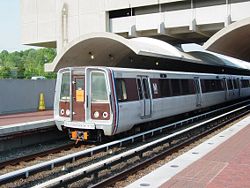
Metro's rail fleet consists of 1,140 75-foot (23 m) rail cars, delivered in five shipments. All rail cars in the Metrorail system operate in married pairs (consecutively numbered even-odd), with systems shared across the pair.
The original order of 300 rail cars was manufactured by Rohr Industries, with delivery in 1976. These cars are numbered 1000-1299 and were rehabilitated in the mid-1990s by Breda Costruzioni Ferroviarie and Metro at the Brentwood Shop in Washington. The second order, of 76 cars, was through Breda Costruzioni Ferroviarie (Breda), with delivery in 1982. These cars are numbered 2000-2075, and were rehabilitated in 2003 and 2004 by Alstom in Hornell, New York. The third order consisted of 290 cars, also from Breda, with delivery in 1987. These cars are numbered 3000-3289 as originally delivered, and are currently undergoing rehabilitation by Alstom in Hornell, New York. The fourth order consisted of 100 cars from Breda, numbered 4000-4099. These cars were delivered in 1991. The fifth order consisted of 192 rail cars from a joint venture of Construcciones y Auxiliar de Ferrocarriles of Spain and AAI Corporation of Hunt Valley, Maryland. These cars are numbered 5000-5191, with delivery from 2001 through 2004. Most recently, Metro has ordered 184 rail cars from Alstom. Delivery began in late 2005, with initial service starting in October 2006. The new cars have their body shells built in Barcelona, and assembly is completed in Hornell, New York.[13]
Metrorail signaling and operation
During normal operation on revenue tracks (used for passenger services), trains are controlled by an automatic train operation system that accelerates and brakes the trains automatically without operator intervention. However, all trains are manned with train operators who close the doors (they can optionally be set to open automatically), make station announcements, and supervise their trains. The operator can manually override a train when necessary.
Safety and security
Design considerations
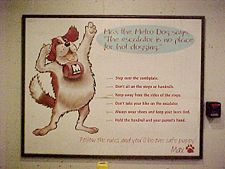
Metro planners designed the system with customer safety and order maintenance as primary considerations. The open vaulted ceiling design of Metro stations and the limited obstructions on platforms allow few opportunities to conceal criminal activity. Station platforms are also built away from station walls, to limit vandalism and provide for diffused lighting of the station from recessed lights. Metro's attempts to reduce crime, combined with how the station environments were designed with crime prevention in mind,[14] has contributed to the fact that Metrorail is among the safest and cleanest subway systems in the United States.[15]
Metro Transit Police
Metro is patrolled by its own police force, which is charged with ensuring the safety of Metro customers and employees. Transit Police officers patrol the Metrorail system and Metrobuses, and they have jurisdiction and arrest powers throughout the 1,500-square-mile (3,900 km2) Metro service area for crimes that occur on or against transit authority facilities, or within 150 feet (46 m) of a Metrobus stop.[16] The Metro Transit Police Department is the only American police agency that has local police authority in three different "state"-level jurisdictions (Maryland, Virginia and the District of Columbia).[17]
Zero-tolerance policy
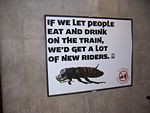
Each city and county in the Metro service area has similar ordinances that regulate or prohibit vending on Metro-owned property, and which prohibit riders from eating, drinking, or smoking in Metro trains, buses, and stations, and the Transit Police have a reputation for enforcing these laws rigorously. One widely publicized incident occurred in 2000 when police arrested a 12-year-old girl for eating french fries in the Tenleytown-AU station.[18] In a 2004 opinion by John Roberts – now the Chief Justice of the United States – the D.C. Circuit Court of Appeals upheld the girl's arrest.[19] By then, however, WMATA had answered negative publicity by adopting a policy of first issuing warnings to juveniles, and arresting them only after three violations within a year.
Metro's zero-tolerance policy on food, trash and other sources of disorder embodies the "broken windows" philosophy of crime reduction. This philosophy also extends to the use of station restroom facilities. A longstanding policy, intended to curb unlawful and unwanted activity, has been to only allow employees to use Metro restrooms.[15] Station managers could make exceptions for customers with small children, the elderly, or the disabled.[20] Today, Metro allows the use of restrooms by customers who gain a station manager's permission, except during periods of heightened terror alerts.[21]
Accidents
On January 13, 1982, a train backed up and derailed at a malfunctioning interlocking between the Federal Triangle and Smithsonian stations. In attempting to restore the train to the rails, the supervisors backed it up, but they did not notice that another car had also derailed. In attempting to reverse the train, the other rail car slid off the track and slammed into a tunnel support, killing three people and injuring many others, becoming the worst accident that has ever occurred on the Metrorail system in over 30 years of operation. Coincidentally, this accident occurred at the same time as Air Florida Flight 90 crashed into the 14th Street Bridge during a major snowstorm, producing probably the worst transit situation in Washington history. The train accident was compounded by lack of availability of ambulances, which at the time were all trying to reach the 14th Street Bridge disaster.[9]
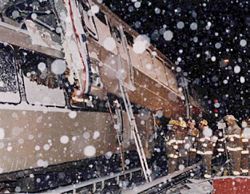
On January 6, 1996, during the Blizzard of 1996, a train operator was killed when a train overran the Shady Grove station and struck a parked train. It was later determined that because operators tended to overuse braking systems and wear them down, only computer-controlled braking was allowed to be used by operators. This operator had asked to be permitted manual control over braking and was refused permission only a few minutes before the computer-controlled braking system failed to stop his train in time. An NTSB investigation found the following factors that contributed to the accident:
- At the time of the accident, there was a policy then in effect that prohibited supervisors from granting employees permission to operate trains manually, even in inclement weather.
- The parked train was located on the same track that was being used by inbound trains, instead of in a safer location.[22]
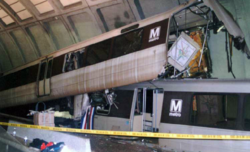
On November 3, 2004, an out-of-service train rolled backwards into the Woodley Park-Zoo/Adams Morgan Station, and hit a revenue train servicing the station.[23] No one was killed, but 20 people were injured.[9] The 2004 accident reinforced the finding from the 1996 accident of the tendency of Metro rail cars built or rehabilitated prior to 2001 to telescope when involved in a head-on collision.[22] A 14-month investigation on the accident concluded that the train operator was most likely not alert as the train rolled backwards into the station, on the grounds that the train had rolled backwards for over 78 seconds and that the train operator was at the end of an overtime shift that had been preceded by a night of interrupted sleep. Safety officials estimated that had the train been full, at least 79 would have died. Since the findings of the investigation, the train operator was dismissed from Metro, and Metro officials plan to add rollback protection to 300 cars.[24]
On November 30, 2006, two Metro employees were struck from behind and killed on the Yellow Line near the Eisenhower Avenue Station while performing routine track maintenance. The operator of the train was found to be at fault in a preliminary investigation for not following appropriate emergency braking procedures. The accident was the third fatal accident involving a Metro employee in a little over a year. An investigation is currently being conducted by the NTSB, and WMATA has announced new maintenance procedures, including limiting track inspections between 10 a.m. and 3 p.m. as well as lowering train speed to 20 miles per hour (32 km/h) when within 600 feet (180 m) of inspectors.
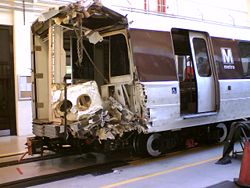
On January 7, 2007, a Green Line train derailed near downtown Washington, sending 16 people to the hospital and prompting the rescue of 60 people from a tunnel. The accident happened at about 3:45 p.m. near the underground Mount Vernon Square station. There were about 150 people on the train. At least one person had a serious but not life-threatening injury. The other injuries were mostly "bumps and bruises", and one of those with minor injuries was pregnant. Part of the six-car train, consisting of 5000-Series cars, had pulled into the station when the fifth car left the track and hit the tunnel wall.[25] About 60 people in the last two cars had to wait about 45 minutes for firefighters to reach them and escort them through the tunnel on a catwalk. Passengers in the first four cars were able to exit on their own through the front two cars, which were already at the station platform. There was no fire, and the cause of the derailment is being investigated. Inbound and outbound trains were sharing a single-track at the time while workers were installing communications cables. It appears that the switch used to route trains between the two tracks may have contributed to the accident. Witnesses said people started to panic when the six-car train began shaking, and some passengers began running to the back of the train. Service on the Green and Yellow lines was halted in both directions around the station, and a shuttle bus took passengers around the accident scene.
There have been several less-serious derailments of Metrorail trains, such as the January 20, 2003, derailment of a Blue Line train near Reagan National Airport.[26]
Random bag searches
On October 27, 2008, Metro officials announced plans to immediately begin random searches of backpacks, purses, and other bags, in a move that they claim will protect riders while guarding their privacy and minimizing delays.[27] In the searches, transit police will randomly choose a number, such as 17. Then they will ask every 17th rider with bags to step aside for an inspection before boarding a bus or entering a rail station. Police also have the right to stop anyone acting suspiciously.[28] Metro cited as legal authority for the searches the court case MacWade v. Kelly, which upheld random searches on the New York City Subway.[29] In an online discussion with Metro Transit Police Chief Michael Taborn, rider opinion was overwhelmingly hostile towards the program. Taborn stated that if someone were to turn around and simply enter the Metro through another escalator or elevator, Metro has "a plan to address suspicious behavior." [30] Security specialist Bruce Schneier characterized the plan as "security theater against a movie-plot threat."[31]
Accountability and controversy
Other serious incidents included an electrical fire on March 18, 2004, during morning rush hour.[32] The fire occurred deep underground, on the Red Line between the Woodley Park-Zoo and Dupont Circle stations. This caused a major disruption in service that sent thousands of stranded passengers onto Connecticut Avenue, with no good plan by authorities to deal with the situation. Occurring just days after the Madrid train bombings, this incident highlighted Metro's shortcomings when it comes to emergency preparedness.
On July 27, 2004, rainstorms flooded a control room located at the Silver Spring station, damaging electronic equipment used for operating Red Line trains between the Takoma and Forest Glen stations. As a result, Red Line trains were manually operated for two weeks, reducing the speed of the trains through the affected area, causing significant delays for passengers.[33]
The Metrorail system has experienced numerous rail cracks that have required single-tracking (trains in both directions sharing the same track) during rush hour. Unlike the New York City Subway and other systems, the original design of the rail system provides just two rail tracks (one in each direction) throughout the entire system; the Metrorail system has no "sidings" for disabled trains to switch onto. Therefore, when an incident occurs, no matter how minor (such as a sick passenger), there is no way for subsequent trains to go around the affected train, causing trains to back up behind the affected train, resulting in quite significant delays. When this happens, trains are "single-tracked" (trains going in both directions sharing the track on the same side), which, again, results in significant delays. Another cause for delays is mechanical break-down of Metrorail trains while they are in service. This causes the entire train to be offloaded, with passengers attempting to reboard onto subsequent trains, which often become packed with the extra passengers.
Further controversy surfaced in 2004, when it became known that employees of Penn Parking, the company contracted by Metro to collect parking fees at Metrorail stations, had stolen substantial amounts of cash. Metro terminated the contract with Penn Parking, and on June 28, 2004, implemented a cashless parking system, in which customers are required to pay for parking with SmarTrip cards.[34]
The parking lots typically fill up quickly on weekdays because of the appeal both for tourists and for commuters from outer suburbs to drive their cars to the outlying stations and take the train in. The cashless parking system created a problem because full, unmanned parking lots trapped drivers who were unable to park and leave without paying $10.00 - the minimum initial cost of a SmarTrip card via the SmarTrip vending machine ($5.00 for the card, and $5.00 initial value). The burden on tourists and single time parkers is highest, because the cost of the card itself is non-refundable and a single time user would be left with an unused balance of $0.25 to $0.50. On January 2, 2006, Metro implemented a change in parking lot revenue hours, so that on weekday mornings, the exit gates from the parking lot would remain open until 10:30 AM.[35]
In 2005, General Manager Richard A. White led efforts to improve accountability and dialogue with customers. This included independent audits, town hall meetings, online chats with White and other management officials, and improved signage in stations. Despite these efforts, however, the Board of Directors announced White's dismissal on January 11, 2006. Dan Tangherlini replaced White as interim General Manager, effective February 16, 2006.[36] Tangherlini was considered a leading candidate for Metro's top job on a permanent basis before he resigned to work as City Administrator under Mayor Adrian Fenty. Tangherlini was replaced as interim general manager by Jack Requa, Metro's chief bus manager. On November 14, 2006, it was announced in The Washington Post that John B. Catoe Jr., the deputy chief executive of the Los Angeles County Metropolitan Transportation Authority, and a Washington, D.C. native, had been selected as Metro's new permanent general manager.[37]
Fare structure
Metrorail fare is not fixed, but varies based on the distance traveled and the time of day at entry. During regular hours (weekdays except federal holidays (see below under "Passes"), from opening until 9:30 am and 3−7 pm, and Friday and Saturday nights from 2:00 a.m. to closing), fares can be anywhere from $1.65 to $4.50. During reduced fare hours (all other times), fares are $1.35, $1.85, or $2.35.[38] Fares can be paid using either farecards or SmarTrip cards. Under either method, users need to use the cards both to enter and exit the stations. The fare is deducted from the balance of the card upon exit.[39]
On December 14, 2007, by a 5-to-1 vote the Metro board approved the largest increases in subway fares and parking fees in the agency's history, the first such increases in four years; the biggest hikes affected rush-hour riders that travel longer distances. Effective January 6, 2008, the subway rush-hour base fare increased by 30 cents, to $1.65 per trip, with the maximum fare increasing from $3.90 to $4.50. There were no increases for off-peak subway fares, making this the first time that the base fare differed between peak and off-peak hours. Bus fares increased by a dime for cash-paying passengers but remained $1.25 for riders who pay with electronic SmarTrip cards.[40][41] After a one year transition, rail-to-bus and bus-to-bus transfers will be issued on SmarTrip cards only.[42] The bus-to-bus transfer period was extended from two to three hours.[43] To increase accessibility of the SmarTrip cards, Metro gave about 50,000 SmarTrip cards to social service agencies for free distribution to low-income bus riders, so that they wouldn't have to pay $5 for one of the rechargeable fare cards.[44]
Passengers having a Metro Access paratransit service card are permitted to ride Metrobus and Metrorail without charge; they display their Metro Access photo ID to the station agent and use the emergency gate to enter and exit the system.
Farecards
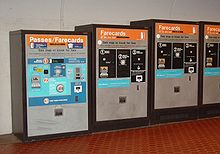
Farecards, unlike the payment systems of many subway systems, must be used twice per trip; once upon entry and once per exit, which is used to compute the variable fare (a similar farecard system is used on the BART system in the San Francisco Bay Area and on the Oyster card system in the London Underground). Farecards and SmarTrip cards can be used for multiple trips; farecards can hold up to $45 in value, although riders are prevented from entering the system – with one exception; see below – if their farecard contains less than the minimum trip value. Seniors and the disabled may obtain "Senior-Disabled" farecards which allow trips for half of the regular fare.[45]
Farecards are reused until the value of the card is zero, at which point (when exiting the system) the gate captures the card. When a card is initially purchased at a farecard dispenser, the amount of the purchase (the "stored value") is printed at the top of it. Each time the card is used, the exit gate prints on the next available line the remaining stored value on the card. In order to enter the Metrorail system, a farecard must have stored value amounting to at least the minimum for the shortest trip from that station. There is one exception: if a rider purchased a bus pass with rail value, the system allows entry if there is any value on the card, because the card cannot be upgraded prior to use. The rider must use the exitfare machine (previously called an "addfare" machine), as indicated below, to bring the card up to the necessary fare amount to exit the system. The card then has zero value, but continues to be valid for bus use. This is also the only means by which one may retain a fare card having a value of zero; any others are captured by the gate.
The stored value remaining on the farecard must meet or exceed the assessed fare, or the outgoing faregate will not allow the rider to exit. If the remaining stored value on a farecard is insufficient, "Exitfare" machines must be used to add to the farecard's stored value before the passenger can exit.[39] Farecards may also be turned in at a farecard issuing machine before entering the system to upgrade the card, and the current stored value may be used toward the purchase of a new farecard. Upon adding funds, the old card is confiscated and a new card is issued. Funds must be added to issue a new farecard, unless the card has been used enough times that all of the space on the card showing the stored value reaches the bottom of the card's printing area; in that case, one may insert the card at a farecard machine and then request issuance of a new card without additional payment. A new card will be issued with the remaining stored value from the previous card printed at the top of the new card.
Passes
There are three types of passes available to most riders: the "One Day Pass", the "7-Day Short Trip Pass", and the "7-Day Fast Pass"; in addition, schoolchildren may use the "SmartStudent Pass".[46] Passes are always issued in the form of paper farecards; a SmarTrip card cannot serve as a pass. These passes are sold in stations by the blue farecard vending machines, or at Metrorail sales facilities (such as at Metro Center).
The One Day Pass costs $7.80 and allows for unlimited travel on Metro from 9:30 a.m. to closing on weekdays, and all day on weekends and all federal holidays. For the 2006–07 season (FY 2007), Metro's board of directors approved a budget that provided for regular weekday service (and therefore, fares[47]) on Columbus Day,[48] Veterans Day,[49] Martin Luther King Day, and Presidents Day, due to high ridership on those federal holidays. However, low ridership on those days did not support operating weekday Metrorail service, so the following year the rail system operated on a modified Saturday schedule, starting at 5 am.[50] It may not be used during the morning rush period.
The 7-Day Short Trip Pass costs $26.40 and is valid for a week from first usage. The pass may be used during peak periods for rides that would normally cost $2.65 or less. Exitfare machines must be used to pay fare exceeding $2.65. Outside of rush periods, the pass may be used for any rail trip.
The 7-Day Fast Pass costs $39 and is also valid for a week from first usage but carries no fare restrictions; it may be used for unlimited Metrorail rides.
The SmartStudent Pass is available for use by students in Washington, D.C., elementary and secondary schools for unlimited travel on Metrorail and Metrobus for school-related purposes. It is not available in farecard machines but is available at Metro sales facilities and some schools within the District of Columbia.
Senior/Disabled farecards and passes may also be purchased at Metrorail sales locations. They function identically to normal passes and farecards, but cost one-half of the standard price; a Medicare card and photo ID must be presented to purchase them. WMATA issues one-month temporary ID cards for those without a Medicare card, obtained in person at WMATA headquarters.
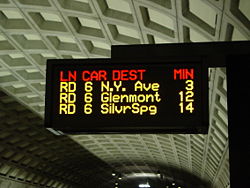
Transfers
Passengers who enter the Metrorail system may transfer between trains for free, so long as they do not exit through the faregates.
Metro offers a discounted rate to passengers transferring from Metrorail to Metrobus of 35¢ on regular routes and $2.10 on express routes if the passenger uses SmarTrip. The transfer rates when using cash are 45¢ on regular routes and $2.20 on express routes. Rail passengers with SmarTrip are automatically charged the reduced transfer fare. Riders paying with farecards must obtain a transfer ticket from dedicated machines inside their origin Metrorail station to obtain the discounted fare.[51]
SmarTrip
Riders can use SmarTrip — a rechargeable, contactless stored-value smart card issued by WMATA — for electronic payment of fares on Metrorail, Metrobus, Fairfax County's Fairfax Connector, Montgomery County's Ride On,[52] Alexandria's DASH, the City of Fairfax's CUE, Arlington Transit (ART), Prince William County's Potomac and Rappahannock Transportation Commission (PRTC), and the DC Circulator bus systems. Since June 28, 2004, SmarTrip cards have been required to park at a Metro-operated parking facility. To use the card, riders touch it to "SmarTrip targets" placed on faregates and fare machines. Up to $300 in value can be stored on a SmarTrip card at any given time.
The SmarTrip card costs five dollars. Riders can buy empty SmarTrip cards at Metrorail sales facilities. Vending machine at some Metrorail stations (major transfer stations; stations with parking facilities) also dispense SmarTrip cards for $10, which includes a $5 initial fare value. SmarTrip cards can also be ordered online for $30, which includes $25 in initial fare value.[53]
Metrorail's "Exitfare" machines predate the introduction of the SmarTrip system; rather than upgrade all Exitfare machines, Metrorail and Metrobus allow riders bearing a SmarTrip card to take one trip which results in a negative balance. However, the card must be brought back to a non-negative balance before it can be used to enter again.[54] This does not apply to Metro parking facilities (since 2005-03-14) or to Ride On; the card must contain sufficient positive value to pay the full cost in order to park[55][56] or to board the bus.[57]
Funding
While fares and advertising provide some revenue for Metro, significant funding is contributed by each jurisdiction that it serves, as well as by the states of Maryland and Virginia. Fares and other revenue fund 57.6% of daily operations while state and local governments fund the remaining 42.4%.[2] Metrorail is unusual among major public transportation systems in having no dedicated source of funding. Instead, each year WMATA must ask each local jurisdiction to contribute funding, which is determined by a formula that equally considers three factors: (1) population density, as of the 2000 Census; (2) average weekday ridership; (3) number of stations in each jurisdiction. Under this formula, the District of Columbia contributes the greatest amount (34%), followed by Montgomery County (18.7%), Prince George's County (17.9%), Fairfax County (14.3%), Arlington County (9.9%), the City of Alexandria (4.7%), the City of Falls Church (0.3%), and the City of Fairfax (0.3%).[58]
It is often argued that this formula places disproportionate burden on District of Columbia taxpayers. WMATA and District officials have pleaded that the Federal government should contribute more funding, reflecting that a substantial portion of the Federal workforce use Metro to commute from the suburbs. Tourists also comprise a significant portion of ridership, and Metro provides an instrumental role in transporting people during special events, such as presidential inaugurations. Several stations located in the District serve these purposes rather than serving local residents.
In 2005, Representative Tom Davis of Virginia introduced bill H.R. 3496, which offered WMATA a ten-year federal funding infusion worth $1.5 billion. The offer was contingent upon WMATA implementing more accountability measures, providing the federal government two seats on its board of directors, and on enactment of legislation by the District of Columbia and the states of Maryland and Virginia to permanently provide WMATA with dedicated sources of revenue worth $150 million per year. The bill passed in the House of Representatives 242-120, but died in the Senate after being referred to a committee until its expiration at the end of the congressional session.[59][60] It is unclear whether the bill will be reintroduced in the 110th Congress.
Future expansion
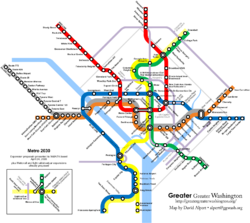
Silver Line
Rumors have abounded for years about transit service to Dulles International Airport and points west, either by Metro or other systems. There was even a study in the early 1990s that proposed a series of civil tiltrotor stations as a possible commuting option from places such as Reston, Manassas, Leesburg, Columbia, and other points in the greater Washington area.[61] Light rail systems and express bus lines have also been suggested as a possibility within the District or Northern Virginia. A rail station was planned for the airport around 1970 and was to be located some 28 feet (8.5 m) below the parking lot area.[62]
In 2002, plans were formalized to bring a 23-mile (37 km) extension to the Orange Line from near the West Falls Church station to Route 772 in Loudoun County, Virginia. This would mean a mass transit connection from Washington proper to the business centers of Herndon, Reston, and Tysons Corner, and provide a link to Dulles Airport. On June 10, 2004, the Federal Transit Administration approved the first phase of the project to begin. It is scheduled to reach Wiehle Avenue in Reston in 2013 and Virginia Route 772, beyond Dulles Airport, in 2015. [63]
Blue Line extension
An extension to Fort Belvoir had been studied in 1999, either as a light rail extension or Metrorail. With the ongoing BRAC realignment expected to move 18,000 jobs to Fort Belvoir by 2012, new interest has been placed on this possible extension. In 2005, it was estimated to cost $700 million to $800 million.[64]
Columbia Pike streetcar
In conjunction with Arlington and Fairfax counties, Metro has proposed to build a streetcar line on Columbia Pike in Arlington.[65]
Green Line extension
Maryland has proposed extending the Green line from the current northern terminus in Greenbelt to connect with Baltimore-Washington International Airport via Fort Meade, home of the National Security Agency. The link would be built in the next two decades to accommodate some of the growth expected in the Howard and Anne Arundel County regions as jobs move in with the recent military reorganization.[66]
M Street subway
To increase travel capacity through downtown DC, a proposal was presented in the early 2000s to reroute the Blue line between Rosslyn and Stadium-Armory, so that it would no longer share tracks with the Orange line. Instead, from Rosslyn, it would pass through a new station in Georgetown, cross the Red line at Dupont Circle and again at Union Station, then rejoin its existing eastward branch at Stadium-Armory.[67] The proposal was eventually rejected for being too expensive.[68]
Southern Maryland transitway
A light rail system for the southern Maryland counties of Charles and St. Mary's is being discussed, growing out of the southern terminus of the Green Line (Branch Avenue) and connecting to the rapidly growing area of Waldorf and other towns along MD Route 5.[69]
Potomac Yard in-fill station
Metro and the City of Alexandria are currently exploring the possibility of adding a Metrorail station in the Potomac Yard area of Alexandria. The station would be built along the existing Blue and Yellow lines between the National Airport and Braddock Road Stations. The project remains in the exploratory stages, and no construction funding (estimated at $150 million) has been obtained. As a result, no timeline for project completion exists.[70]
Blue Line realignment
In October 2008, Metro released the results of a study related to the possible rerouting of some Blue Line trains over the Fenwick Bridge, creating a service running between Franconia-Springfield and Greenbelt. The new alignment was marked in brown on a draft map, and research determined that a new line color was key to acceptance.[71]
Proposed projects from other agencies
Purple Line
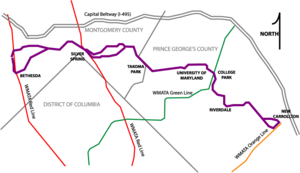
Controversy has attended proposals to build a Purple Line, linking Bethesda and Silver Spring, Maryland, thereby connecting the two branches of the Red Line to the north of Washington by rail. It would later be possibly extended to New Carrollton, Maryland, thus also connecting branches of the Green and Orange lines, and eventually around the entire Capital Beltway, linking all the Metro endpoints together, as seen in a proposal from the Sierra Club.[72] This line has been conceived as a light rail line traveling along a private right-of-way for at least some portion of its length, as an elevated monorail, and also as a rapid bus line. The proposal has met fierce opposition from some of the residents along the certain areas of the line. Others have noted difficulties in obtaining the funds to build it.[73]
Corridor Cities Transitway
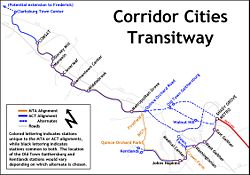
A proposed light rail or bus rapid transit line that is planned to run from the Shady Grove Metro station in Gaithersburg, Maryland northwest to Clarksburg, Maryland.
Anacostia and Benning Road streetcar
The District of Columbia Department of Transportation has developed plans for two streetcar projects in Northeast and Anacostia.
Mobile phone service
Verizon Wireless is currently the only wireless phone company (initially under the corporate name Bell Atlantic) to provide service in the underground sections of the system, since 1997. Users of other carriers may be able to get service underground by roaming onto Verizon's network. There are negotiations under way to open this underground service to other wireless carriers.[74][75]
See also
- List of rapid transit systems
- List of United States rapid transit systems by ridership
- List of Washington Metro stations
- Megaproject
- Metrobus
- SmarTrip
- United States Capitol Subway System
References
- ↑ 1.0 1.1 1.2 WMATA (2008-07-08). "215 million people rode Metrorail in fiscal year 2008". Press release.
- ↑ 2.0 2.1 "WMATA Facts" (PDF). WMATA (July 2006). Retrieved on 2006-08-18.
- ↑ "Pipeshaft - Forest Glen".
- ↑ MetroRail 4th of July Service Patterns from Oren's Transit Page
- ↑ WMATA (August 9, 2004). "Entire Metrobus fleet now equipped with new SmarTrip fareboxes". Press release.
- ↑ WMATA (December 4, 2006). "New Signs announce January Yellow Line Extension to Fort Totten". Press release.
- ↑ "Harland Bartholomew: His Contributions to American Urban Planning" (PDF). American Planning Association. Retrieved on 2006-11-22.
- ↑ Schrag, Zachary (2006). The Great Society Subway: A History of the Washington Metro. Johns Hopkins University Press. ISBN ISBN 0-8018-8246-X.
- ↑ 9.0 9.1 9.2 9.3 9.4 9.5 "WMATA History" (PDF). WMATA. Retrieved on 2006-08-18.
- ↑ 10.0 10.1 Schrag, Zachary M.. "Planning: The Adopted Regional System, 1966-1968". Retrieved on 2006-08-17.
- ↑ “All-Time High Set for Metro Ridership”, Associated Press (July 14, 2008). Retrieved on 2008-07-14.
- ↑ Layton, Lyndsey (2006-02-02). “Metro Chooses New ‘Doors' Voice”, The Washington Post, p. B01.
- ↑ Information on the cars from The Schumin Web Transit Center
- ↑ La Vigne, Nancy G. (1997, November). "Visibility and Vigilance: Metro's Situational Approach to Preventing Subway Crime (Research in Brief)" (PDF). National Institute of Justice, U.S. Department of Justice.
- ↑ 15.0 15.1 La Vigne, Nancy G. (1996). "Safe Transport: Security by Design on the Washington Metro (Chapter 6)". in Clarke, Ronald V. (editor). Preventing Mass Transit Crime. Criminal Justice Press. ISBN 1881798283.
- ↑ "Washington Metropolitan Area Transit Authority Compact". WMATA. Retrieved on 2006-08-19.
- ↑ "Metro Transit Police Department". WMATA. Retrieved on 2006-08-19.
- ↑ Sullivan, Emmet G. (2003-09-30). "Hedgepeth v. WMATA, et al." (PDF). United States District Court for the District of Columbia.
- ↑ Hedgepeth v. Washington Metropolitan Area Transit Authority, 386 F.3d 1148 (D.C. Cir. 2004) (Argued September 17, 2004 Decided October 26, 2004)
- ↑ Layton, Lyndsey (2003-01-05). “If You Have to Go, Perhaps Soon You Can Go on Metro”, The Washington Post, p. C04.
- ↑ WMATA (August 10, 2006). "Metro steps up security as a precaution after foiled London terror plot". Press release.
- ↑ 22.0 22.1 Report of the 1996 crash from the NTSB
- ↑ Layton, Lyndsey and Ginsberg, Steven (November 4, 2004). “20 Injured in Crash of 2 Red Line Trains”, The Washington Post, p. A01.
- ↑ Sun, Lena H. (March 23, 2006). “Dozing Operator Blamed in Rail Accident”, The Washington Post, p. A01.
- ↑ Klein, Allison and Martin Weil (January 8, 2007). “Green Line Metro Train Derails; at Least 18 Hurt”, The Washington Post.
- ↑ “Safety Warnings Often Ignored at Metro”, The Washington Post (June 6, 2005), p. A01. Retrieved on 2008-05-19.
- ↑ WMATA (October 27, 2008). "Metro Transit Police to begin bag inspection program". Press release.
- ↑ Lena H. Sun (Tuesday, October 28, 2008). “Metro to Randomly Search Riders' Bags”, The Washington Post, p. A01.
- ↑ MTPD Security Inspection Program FAQ
- ↑ Metro Transit's Top Cop Discusses New Search Policy(Tuesday, October 28, 2008; 1:30 PM)
- ↑ Bruce Schneier Talks Metro Bag Searches(Friday, October 31, 2008; 12:00 PM)
- ↑ Barbash, Fred (March 18, 2004). “Electrical Fire Shuts Down Metro's Red Line”, The Washington Post.
- ↑ Layton, Lyndsey (August 5, 2004). “Slow Service On Red Line Angers Riders”, The Washington Post, p. B01.
- ↑ Layton, Lyndsey (May 22, 2004). “Metro Hires New Management for Parking Lots”, The Washington Post, p. B03.
- ↑ WMATA (December 29, 2005). "Metro's new system-wide time change for paying to exit Metrorail parking facilities takes effect Monday, January 2". Press release.
- ↑ Layton, Lyndsey (January 12, 2006). “Metro Drops Longtime Manager”, The Washington Post, p. A01.
- ↑ Sun, Lena H. (November 14, 2006). “Metro Picks L.A. Official, D.C. Native As Manager”, The Washington Post, p. A01. Retrieved on 2006-11-15.
- ↑ "Fares and Passes". WMATA.
- ↑ 39.0 39.1 "How to use Metrorail faregates". WMATA. Retrieved on 2006-09-11.
- ↑ Lena H. Sun (December 14, 2007). “Metro Passes Largest Fare Hikes in Its History”, Washington Post, p. A01.
- ↑ WMATA. "Metro Board approves first fare hike in four years". Press release.
- ↑ "New Metro Fares and Fees Effective January 6, 2008". WMATA. Retrieved on 2008-01-16.
- ↑ "NEW METRO FARES AND FEES Effective January 6, 2008" (PDF). WMATA. Retrieved on Dec. 16, 2007.
- ↑ Lena H. Sun (December 16, 2007). “Increases In Fares, Service Unequal”, Washington Post, p. C01.
- ↑ "Metro passes and farecards". WMATA. Retrieved on 2006-09-11.
- ↑ "Metrorail passes". WMATA. Retrieved on 2008-01-15.
- ↑ "Metro 2008 holiday schedule". WMATA. Retrieved on 2008-01-15.
- ↑ WMATA (October 5, 2006). "Metro to operate regular weekday service on Columbus Day". Press release.
- ↑ WMATA (November 8, 2006). "Metro to Operate Regular Weekday Service on Veterans Day". Press release.
- ↑ WMATA (October 3, 2007). "Metro to operate holiday service on Columbus Day". Press release.
WMATA (November 8, 2007). "Metro to Operate Holiday Service on Veterans' Day". Press release.
WMATA (January 18, 2008). "Metro to operate modified service on Martin Luther King, Jr. Day". Press release.
WMATA (February 15, 2008). "Metro to operate holiday service on Presidents' Day". Press release. - ↑ "WMATA - General Metrobus information (Transfers)". WMATA.
- ↑ "Ride On Fares". County web site. Montgomery County, Maryland. Retrieved on November 10, 2007.
- ↑ "SmarTrip — It's easy to buy SmarTrip.". WMATA. Retrieved on December 7, 2007.
- ↑ "SmarTrip — Points to remember". WMATA. Retrieved on December 7, 2007.
- ↑ WMATA (March 2, 2005). "Customers Reminded to Have Enough Value on SmarTrip Cards to Pay Full Parking Fees at Metro-Operated Lots". Press release.
- ↑ ""Be sure you have enough money on your SmarTrip card to pay for parking."" (PDF brochure). WMATA (eff. March 14, 2005).
- ↑ ""Smarlrip On Ride On"" (PDF brochure). Montgomery County DPWT, Division of Transit Services (eff. April 29, 2007).
- ↑ WMATA Subsidy Allocation Methodology (PDF)
- ↑ Lena H. Sun (July 18, 2006). “House Backs $1.5 Billion For Metro — With a Hitch”, The Washington Post, p. A01.
- ↑ THOMAS Library of Congress website; search for H.R. 3496 (109th Congress)
- ↑ Civil Tiltrotor Feasibility Study for the New York and Washington Terminal Areas (PDF)
- ↑ Metrorail Track and Structures at Clouse.org
- ↑ "Dulles Metrorail is Coming" (PDF). Dulles Corridor Metrorail Project (December 2007). Retrieved on Jan. 14, 2008.
- ↑ Smith, Leef (May 20, 2005). “Metro Studies Ft. Belvoir Extension”, The Washington Post, p. B01.
- ↑ "Pike Transit Initiative".
- ↑ McGowan, Phillip (June 9, 2005). “Fort Meade proposes Metro extension”, The Baltimore Sun.
- ↑ "NARPAC - Metro Long Range Planning".
- ↑ Whoriskey, Peter (April 15, 2005). “Choke Point Slows Orange Line Trains”, The Washington Post, p. B01.
- ↑ Paley, Amit R. (February 13, 2005). “Dyson Pushes Light Rail, Expansion of Bridge”, The Washington Post, p. SM01.
- ↑ Sun, Lena H. (June 6, 2008). “New Push For Metro Station in Alexandria”, The Washington Post, p. B01.
- ↑ [1]
- ↑ Purple Line proposal from the Sierra Club
- ↑ Bickering over Purple Line could cause funding woe — Gazette.net
- ↑ Hammer, Ben (2006-02-17). "Metro pushes Verizon to open wireless network". Washington Business Journal. Retrieved on 2007-05-25.
- ↑ "Today's Editorial: No $1.5 billion subsidy for Verizon". The Washington Times (2007-04-30). Archived from the original on 2007-06-03. Retrieved on 2007-05-25.
External links
- Washington Metropolitan Area Transit Authority Official site
- Metro Transit Police Official site
- StationMasters Online Neighborhood maps and panoramic photographs of each station
- MetroRiders.Org Metro Customer Advocacy Group
- Dulles Corridor Metrorail Project
- Dulles Corridor Rail Association
- Metro Compact
- Building the Washington Metro
Transit enthusiast sites
- world.nycsubway.org Washington Metro
and its archived version featuring a link to a track map that was removed post-9/11 at the request of WMATA - The Schumin Web Transit Center (Washington Metro) broken archive version
- Oren's Transit Page (Washington, D.C.)
- UrbanRail.net Washington Metro
- John R. Cambron. "Various Documents, Pictures and Maps of Washington Metro". Archived from the original on 2007-05-09.
- Home Page of John R Cambron
- "The Pipeshaft: Infrastructure of the D.C. Metrorail". Archived from the original on 2007-04-17.
- GP Bus Gallery
Maps
- ShouldIMetro.com Interactive map of the DC metro system that calculates distances from addresses to the nearest Metro stop and provides useful info like next train times.
- MetroMapr.com Interactive Google Maps of the transit systems in Boston, DC, and Philadelphia with search.
- DCRails.com Google Maps representation of Metrorail with address lookup.
- An alternate Google Maps representation showing all lines drawn in
- Track schematic of 106 Mile System
- Track schematic of 129 mile system (Dulles Corridor Metrorail Project)
- Planned 2030 Track schematic
- Possible future map of Washington Metro
- Stationmasters, map of the Washington Metro with 360-degree photos of each station's surroundings and highly detailed local maps
Equipment
- Document describing line nomenclature, operation and signaling (Site broken. Archived version.)
- Swiger Coil Systems
- Cast Solutions, Inc.
|
|||||||||||||||||||
|
|||||||||||||||||
|
|||||